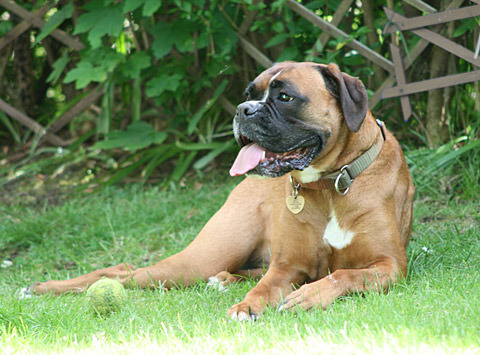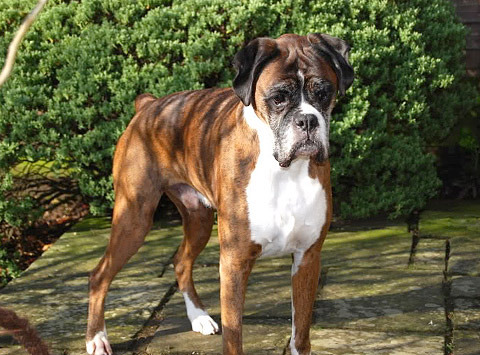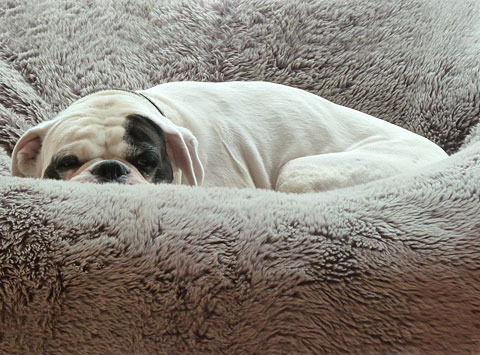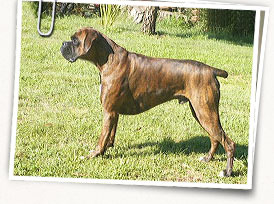Origin
Developed in Germany in the 1830s from the mastiff-type Bullenbeissers and the English Bulldog to bring down game, to guard, and to bait bulls and bears, the modern Boxer retains the strength, bravery, tenaciousness and agility of his ancestors. These traits have seen the Boxer become a favoured breed for military and police duties. His loyal and affectionate nature make him an excellent companion as well as a valuable assistance and therapy dog. Most of today’s pedigree Boxers can trace their lineage back to the dogs of Friederun and Philip Stockmann’s legendary ‘von Dom’ kennels, especially their ‘big four’ Sigurd, Lustig, Utz, and Dorian who were of supreme importance in the development of the breed.
Character
As a guarding breed the Boxer is alert, self-assured and fearless, but it would be totally uncharacteristic for the breed to show any sign of aggression towards humans unless under extreme provocation. The attitude of the Boxer towards other dogs may vary, but generally they will not initiate a fight and will respond in kind to friendly overtures. However, should your Boxer be challenged he is very unlikely to back down. Extremely people-orientated a Boxer needs to be fully one of the family and to be included in as many activities as possible. This is definitely not a dog to be kennelled outside as not only can they not stand extremes of heat and cold but, if left alone, will become depressed, bored and miserable. A superb family dog with a natural love of, and gentleness with, children and possessed of a genuine joy in life, the Boxer will remain trustworthy and playful even in old age.
Exercise
An energetic and athletic dog the adult Boxer requires plenty of exercise. Two good walks per day plus the opportunity for free-running in a secure area will keep him fit and trim. Boxers enjoy, and do well in, canine sports such as agility, frisbee, tracking, Schutzhund, etc.. Exercise in the heat of the day should be avoided as Boxers, due to their short muzzles, can become over-heated very quickly. Mental stimulation is also necessary. This can be achieved through training exercises and games which will keep the mind active. Boxer puppies do not need, and should not have, much formal exercise until around 10+ months of age.
Training
It is a common misconception that Boxers are difficult, if not impossible, to train. They tend to be dismissed as clowns, fools, eternal puppies, etc.. The fact is that Boxers are extremely intelligent and this, allied to their willingness to please, makes training quite easy. The key is to keep everything fun for your Boxer and to employ kindness, patience and consistency. They tend to ‘switch off’ when bored so it is important to ensure that training is not overly repetitive or tedious but interesting, challenging, and enjoyable. Harsh verbal or physical corrections must be avoided as they are unnecessary and counter-productive and your Boxer will respond far more willingly to positive reinforcement. It is important that the Boxer should receive early and constant socialization with people and other dogs to avoid any possibility of shyness or aggression.
Health
- Cancer
- aortic stenosis
- sub-aortic stenosis
- cardiomyopathy
- hypothyroidism
- susceptible to bloat
Pictures
Some photographs of the Boxer...

Star, owned by Carole in Scotland, UK
Star at age 6 years. Doing what she loved best, sunbathing and playing with her ball.

Bandit, owned by Jackie in Staffordshire, UK
Bandit, brindle Boxer - he was around 7 in this pic. What can you say about this boy? He was the love of my life, lived it, with a what's in it for me attitude, but at heart was his mummies baby x

Finn, owned by Carole in Scotland, UK
Finn, a white Boxer at 7 years old. The laziest boxer around, enjoys nothing more than a good sleep.





